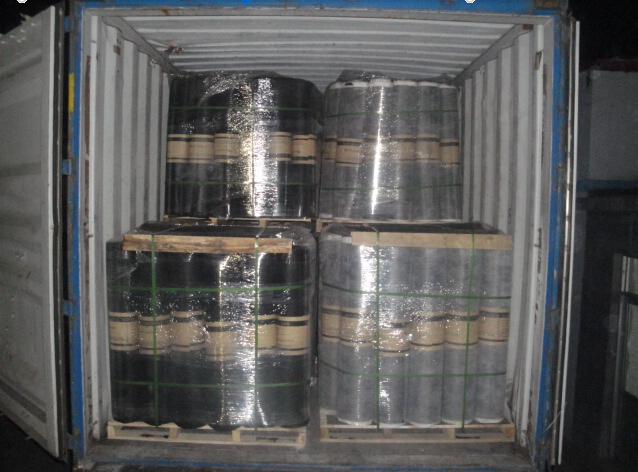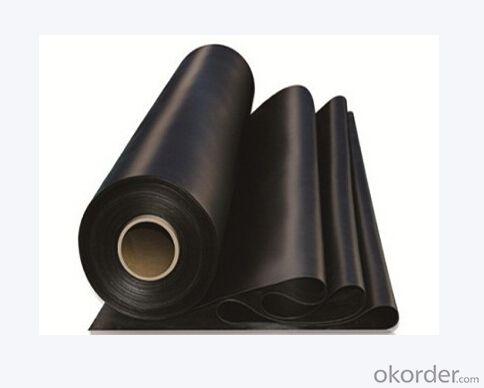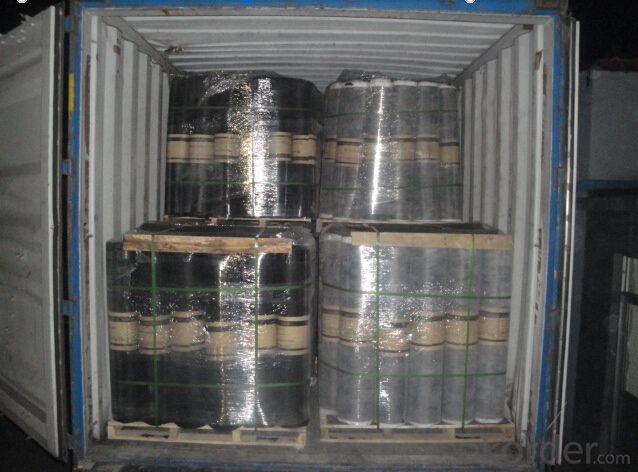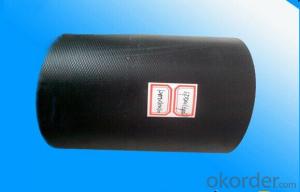EPDM Rubber Roof Waterproof Membrane with High Quality
- Loading Port:
- Qingdao
- Payment Terms:
- TT OR LC
- Min Order Qty:
- 2000 m²
- Supply Capability:
- 10000 m²/month
OKorder Service Pledge
OKorder Financial Service
You Might Also Like
Epdm Rubber Roof in Rolls Membrane
Characteristics:
Good synthesis aging resistance;ozone resistacne;ultravoilet resistance;chemical resistance;corrosion resistance.High tensile strength and good elasticity;endured the puncture-resistant and cracking resistance.
Specification:
With: 1m-4m
Length: 20m
Thickness:1.2mm;1.5mm;2mm
Packing:

Technical Data:
Technical Capacity Index(Ref to Chinese Standard GB18173.1-2006) | ||
EPDM Rubber Waterproof Membrane | ||
No. | Item | Index |
1
|
Water tightness |
≥0.3 Mpa,No leakage
|
2 | Tensile strength | ≥7.5Mpa |
3 | Elongation at break% | ≥450 |
4 | Tearing strength,KG/m | ≥25 |
5 | Brittleness point | ≤-40 |
Application
Widely used in roofs, basement, toilet ,swimming pool, and all kinds of industry and civil building waterproofing, reservoir, vivicism, bridge, underground, tunnel and dam waterproofing ,especially to the keystone waterproofing projects which is durability, high corrosion resistance and easy deformation


- Q:Can a waterproofing membrane be used for fire pit areas?
- No, a waterproofing membrane should not be used for fire pit areas. While waterproofing membranes are designed to prevent water penetration, they are not designed to withstand the high temperatures and potential fire hazards associated with fire pits. Fire pit areas require specific fire-resistant materials that can withstand the heat generated by the fire and prevent any potential fire accidents. It is important to use appropriate materials that are specifically designed for fire pit areas to ensure safety and prevent any potential damage.
- Q:Is a waterproofing membrane environmentally friendly?
- Yes, a waterproofing membrane can be considered environmentally friendly. Waterproofing membranes are designed to prevent water leakage and damage to structures, which can contribute to the longevity of a building and reduce the need for repairs or replacements. This can result in a reduction in construction waste and the overall environmental impact of the building industry. Furthermore, some waterproofing membranes are made from eco-friendly materials, such as recycled content or bio-based materials, which can help reduce the carbon footprint associated with their production. Additionally, these membranes can be designed to be recyclable or biodegradable, further reducing their environmental impact at the end of their life cycle. Moreover, by preventing water infiltration, waterproofing membranes can help protect the structural integrity of buildings, preventing moisture-related issues such as mold growth and rot. This can contribute to maintaining a healthy indoor environment and reducing the need for energy-intensive remediation measures. It is important, however, to consider the specific characteristics and certifications of a waterproofing membrane to assess its environmental friendliness accurately. Look for certifications such as LEED (Leadership in Energy and Environmental Design) or products that have undergone life cycle assessments to ensure that they meet rigorous environmental standards. In summary, while not all waterproofing membranes may be inherently environmentally friendly, the use of certain materials and the prevention of water damage can make them a sustainable choice for building projects.
- Q:Can a waterproofing membrane be used on tunnels with vehicular traffic?
- Yes, a waterproofing membrane can be used on tunnels with vehicular traffic. Waterproofing membranes are commonly employed in tunnels to prevent water infiltration and protect the structure from moisture damage. These membranes are designed to withstand heavy loads and provide a durable and reliable barrier against water penetration. However, it is crucial to choose a membrane specifically engineered for vehicular traffic tunnels to ensure it can withstand the dynamic forces and stress imposed by vehicles.
- Q:Can a waterproofing membrane be used for industrial applications?
- Industrial applications can indeed utilize waterproofing membranes. These specialized membranes are designed specifically to create a barrier against water infiltration, and they can be employed in various industrial settings that require protection against water intrusion. Industries like construction, manufacturing, and transportation commonly employ these membranes to safeguard structures, equipment, and products from water damage. Furthermore, they can be applied to various surfaces such as roofs, walls, floors, and underground structures, providing durable waterproofing solutions that endure over time. The remarkable resilience of waterproofing membranes allows them to withstand even the harshest environmental conditions, chemicals, and high temperatures. This exceptional durability makes them particularly suitable for industrial applications that necessitate resistance to these elements. In summary, waterproofing membranes offer a dependable and efficient solution for industrial waterproofing requirements.
- Q:Can a waterproofing membrane be used on concrete walls?
- Concrete walls can benefit from the use of a waterproofing membrane. These membranes are specifically designed to prevent water from penetrating the surface and can be applied to various surfaces, including concrete walls. Common materials used for these membranes include modified bitumen, rubberized asphalt, and synthetic polymers, all of which are highly resistant to water and moisture. By applying a waterproofing membrane to concrete walls, one can effectively prevent water seepage, dampness, and potential damage caused by water infiltration. The membrane acts as a protective barrier, stopping water from permeating through the concrete and reaching the interior spaces. Additionally, it helps maintain the structural integrity of the concrete by reducing the risks of cracks, efflorescence, and other forms of moisture-related deterioration. There are several types of waterproofing membranes available in the market, such as sheet membranes, liquid membranes, and cementitious coatings. The choice of the membrane depends on factors such as the specific application, the degree of water exposure, and the condition of the concrete wall. It is essential to select a membrane that is compatible with the concrete and provides long-lasting waterproofing protection. Before applying the membrane, it is crucial to properly prepare the concrete surface. This involves tasks such as cleaning, repairing any cracks or imperfections, and ensuring that the surface is dry and free from contaminants. The membrane is then installed according to the manufacturer's instructions, which usually involves adhering it to the concrete or applying a liquid membrane with a brush or roller. To sum up, a waterproofing membrane is a valuable solution for protecting concrete walls from water infiltration. By choosing the right type of membrane and following proper installation procedures, one can effectively preserve the durability and longevity of the concrete while safeguarding the interior spaces from potential water damage.
- Q:Can a waterproofing membrane be applied to wood surfaces?
- Yes, a waterproofing membrane can be applied to wood surfaces. There are various types of waterproofing membranes available on the market, such as liquid membranes or sheet membranes, that can be specifically designed for wood surfaces. These membranes are typically made of materials like rubber, asphalt, or polyurethane, which provide a protective barrier against water and prevent moisture from penetrating the wood. The waterproofing membrane is applied to the wood surface using different methods, depending on the product, such as brushing, rolling, or spraying. Applying a waterproofing membrane to wood surfaces can help prolong the lifespan of the wood, prevent rotting or warping, and protect it from water damage. However, it is important to ensure proper surface preparation and follow the manufacturer's instructions for application to achieve the best results.
- Q:Can a waterproofing membrane be used on precast stone surfaces?
- Yes, a waterproofing membrane can be used on precast stone surfaces. The membrane acts as a protective barrier, preventing water from penetrating the stone and causing damage. It is commonly used in construction projects to ensure the longevity and durability of precast stone surfaces.
- Q:Can a waterproofing membrane be used in elevator pits or sump pits?
- Certainly! Below is a rewritten version of the passage: Indeed, elevator pits or sump pits can benefit from the utilization of a waterproofing membrane. These pits are prone to water infiltration, but the application of a waterproofing membrane can effectively prevent water seepage. By acting as a barrier, the membrane stops any water from entering the pit and causing harm to the elevator or pumping system. Consequently, this safeguards the longevity and integrity of the elevator or pump. Moreover, the waterproofing membrane also safeguards the surrounding structures from water damage. Thus, it is crucial to select a suitable waterproofing membrane that is specifically designed for below-ground applications and possesses the necessary properties to withstand the unique conditions within an elevator or sump pit.
- Q:Can a waterproofing membrane be used on aluminum surfaces?
- Indeed, aluminum surfaces can benefit from the application of a waterproofing membrane. Such membranes possess great versatility, enabling their use on a wide range of surfaces, including aluminum. Their purpose is to create a safeguarding barrier against water and moisture, effectively preventing any potential leaks or water-related harm. By employing a waterproofing membrane on aluminum surfaces, the material's longevity can be significantly extended as it remains protected from the detrimental effects of corrosion and rust, which are often triggered by water exposure. Nevertheless, it is imperative to carefully select a waterproofing membrane that is both compatible with aluminum and suitable for the specific application in order to achieve the most optimal outcomes.
- Q:Can a waterproofing membrane be used for a roof?
- Yes, a waterproofing membrane can be used for a roof. Waterproofing membranes are specifically designed to provide a barrier against water penetration, making them an ideal choice for protecting roofs from leaks and water damage. They are durable, flexible, and can be applied to various types of roofs, including flat and sloped surfaces.
1. Manufacturer Overview |
|
|---|---|
| Location | |
| Year Established | |
| Annual Output Value | |
| Main Markets | |
| Company Certifications | |
2. Manufacturer Certificates |
|
|---|---|
| a) Certification Name | |
| Range | |
| Reference | |
| Validity Period | |
3. Manufacturer Capability |
|
|---|---|
| a)Trade Capacity | |
| Nearest Port | |
| Export Percentage | |
| No.of Employees in Trade Department | |
| Language Spoken: | |
| b)Factory Information | |
| Factory Size: | |
| No. of Production Lines | |
| Contract Manufacturing | |
| Product Price Range | |
Send your message to us
EPDM Rubber Roof Waterproof Membrane with High Quality
- Loading Port:
- Qingdao
- Payment Terms:
- TT OR LC
- Min Order Qty:
- 2000 m²
- Supply Capability:
- 10000 m²/month
OKorder Service Pledge
OKorder Financial Service
Similar products
New products
Hot products
Related keywords




























